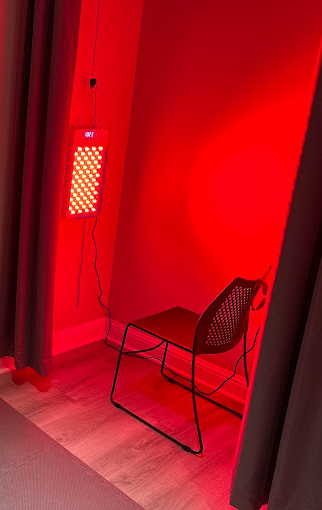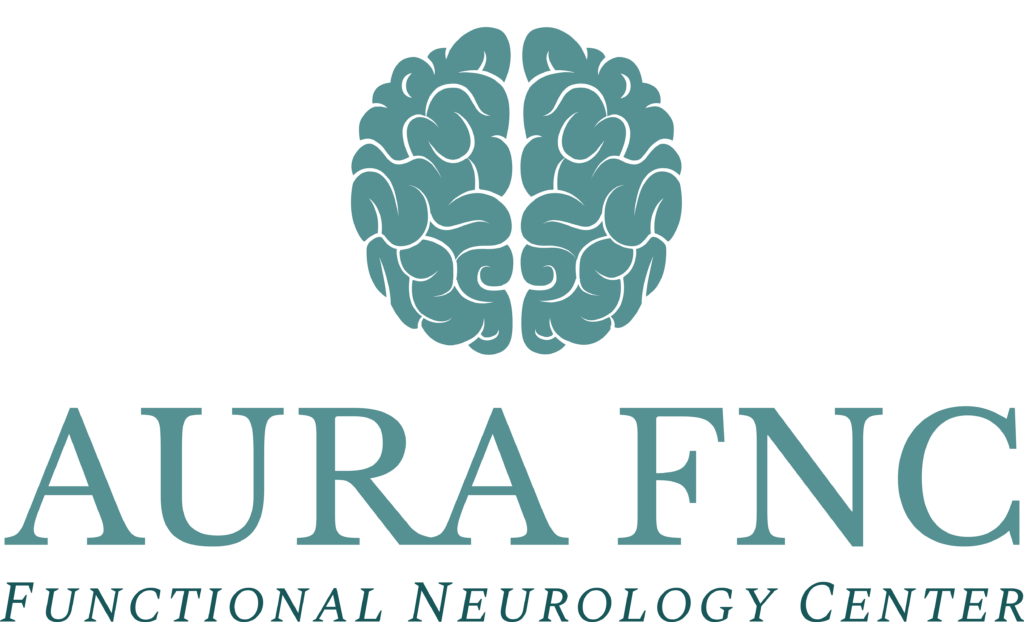Red Light Therapy
What is Red Light Therapy? (RLT)
Red Light/Near-Infrared Light uses specific infrared wavelengths to penetrate deeply into the brain, making it a non-invasive brain stimulation (NIBS) technique, and is commonly referred to as red light therapy (RLT). Studies have demonstrated that photobiomodulation (PBM) induces brain plasticity by increasing synaptic strength, modulating neurotransmitters, and altering neural pathways.
These trigger a range of biological responses on a cellular level, such as positively affecting levels of adenosine triphosphate (ATP), DNA, and RNA, as well as releasing compounds like nitric oxide (NO) and cytochrome c oxidase (CcO) for cellular energy.
Red light therapy also regulates reactive oxygen species (ROS) which are the main contributors to inflammation system-wide. At Aura FNC we use LED panels as part of our treatment programs for treating neurological disorders like migraine, dysautonomia, POTS, concussion, TBI, long COVID, FND, and neurodevelopmental disorders.

Dr. Diana Tyler DC, DACNB
Founder of Aura FNC with experience using red light therapy (RLT) with her patients at the Aura FNC office located in Cumming, Georgia right outside the Atlanta area. Doctor of Chiropractic and Functional Neurologist. Graduate of Palmer College of Chiropractic and a Diplomate of the American Chiropractic Neurology Board.
History of Red Light Therapy

Red light therapy has a history dating back to the mid-20th century when its potential benefits were discovered. Initially developed for its effects on wound healing and tissue repair, red light therapy gained attention for its ability to stimulate cellular activity without causing damage. Over the years, research has expanded its applications to various medical fields, including functional neurology, dermatology, sports medicine, and chronic pain management.
Mechanism of Action for RLT
The mechanism of action behind red light therapy lies in its ability to penetrate the skin and reach the mitochondria within cells. Mitochondria are the powerhouse of cells, responsible for producing energy in the form of ATP. When exposed to red or near-infrared light, mitochondrial function is enhanced, leading to increased ATP production. This boost in cellular energy facilitates various cellular processes, such as improved metabolism, increased circulation, and enhanced tissue repair. Additionally, red light therapy has been shown to modulate inflammation and oxidative stress, contributing to its therapeutic effects in different medical applications.
Collagen production
One notable application of red light therapy is its impact on collagen production. Collagen, a crucial protein for skin elasticity and structure, is stimulated by red light, leading to improved skin tone and reduced signs of aging. This collagen-boosting effect makes red light therapy a popular choice in the cosmetic and skincare industry, offering a non-invasive approach to enhance skin health and appearance.
Wound healing
Red light therapy has demonstrated significant benefits in wound healing processes. By promoting cellular repair and reducing inflammation, red light therapy accelerates the healing of wounds, injuries, and surgical incisions. This application has found use in both clinical settings and home care for conditions ranging from chronic wounds to post-surgery recovery.
Anti-inflammatory effects
The anti-inflammatory effects of red light therapy make it valuable in managing various inflammatory conditions, such as arthritis and muscle injuries. By modulating inflammatory responses at the cellular level, red light therapy helps alleviate pain and improve functional outcomes in individuals with inflammatory disorders.
Types of Red Light Therapy Devices
Red light therapy devices come in various forms, catering to different applications and preferences. Light-emitting diode (LED) panels, laser devices, and handheld devices are common types. LED panels are versatile and cover larger areas, making them suitable for full-body treatments, which is what we use at Aura FNC for our RLT. Laser devices, with more focused and intense light, are often used for targeted treatments. Handheld devices offer portability and convenience, allowing users to target specific areas for localized therapy.
Light therapy devices
Light therapy devices encompass a broader category that includes both red light therapy and other forms of light-based therapies, such as blue light for acne treatment and white light for mood enhancement. These devices can range from simple LED masks for facial treatments to sophisticated light pods used in clinical settings. Each type of light therapy device is designed to harness the unique therapeutic properties of specific wavelengths for diverse health and wellness applications. While red light therapy can commonly be associated with therapies like cold laser therapy or low-level laser therapy (LLLT), they are not the same and can both be used for treating different neurological or physiological conditions.
Understanding Red Light Therapy (RLT) vs Low-Level Laser Therapy (LLLT)
- Red Light Therapy (RLT) using LED Panels:
When someone refers to red light therapy, they are most often referencing the use of light-emitting diode panels (LEDs) that emit red or near-infrared light. These panels cover larger surface areas, making them suitable for full-body treatments. The mechanism of action involves the penetration of light into the skin, reaching the mitochondria within cells. This exposure stimulates cellular activity, promoting processes such as increased ATP production, enhanced metabolism, and improved tissue repair. RLT using LED panels is often employed for applications such as collagen production, wound healing, anti-inflammatory effects, and overall cellular rejuvenation. - Cold Laser Therapy or Low-Level Laser Therapy (LLLT):
LLLT, commonly referred to as Cold Laser Therapy, uses low-level lasers or coherent light sources to deliver targeted light energy to specific areas of the body. Unlike LED panels, which emit non-coherent light, lasers provide a more focused and intense beam. LLLT is often used for localized treatments, targeting specific points or smaller areas with precision. The mechanism of action is similar to RLT, involving the stimulation of cellular activity and modulation of various cellular processes, but more concentrated. LLLT is applied in various medical fields, including functional neurology, pain management, sports medicine, and dermatology.
Each modality has its unique advantages and is chosen based on the specific therapeutic goals set between you and Dr. Diana Tyler, and the area of the body being treated.
